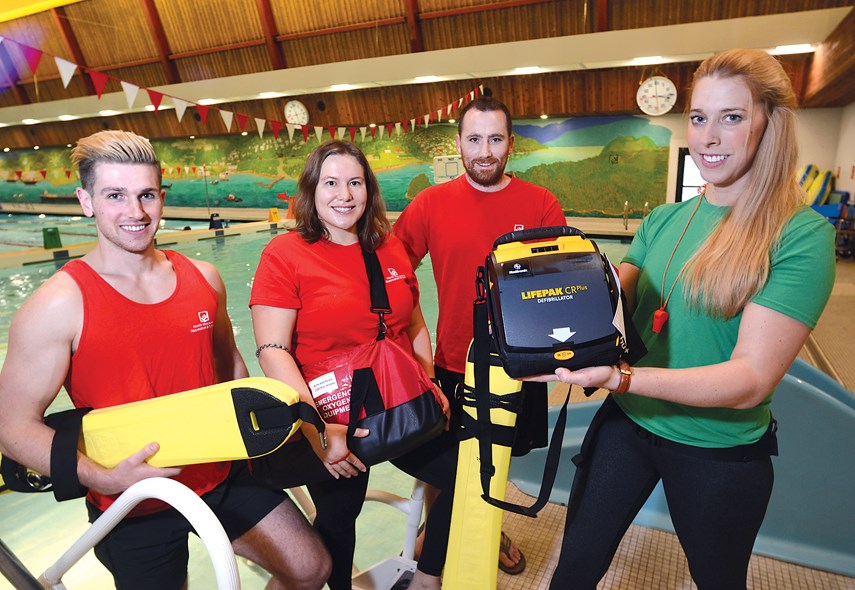Their collective years of training led up to the lifesaving moment.
All was normal just before noon on Nov. 8 at Ron Andrews rec centre. Aquatics supervisor Katryna Gavin, about to go for a workout, grabbed some headphones from her desk that overlooks the pool.
An off-duty lifeguard happened to be in the weight room that morning.
Gavin heard the unmistakeable scream, and ran down the deck – justifiably breaking the cardinal rule of the pool.
Other lifesaving team members at Ron Andrews also jumped into action.
As the off-duty lifeguard called 911, Gavin grabbed the automated external defibrillator and oxygen cylinder and made a beeline for the deep end.
“He had been pulled out by that time, and we quickly assessed him and found out he wasn’t breathing,” recalls Gavin, of the dramatic rescue from the bottom of the pool where the man laid unconscious.
CPR was started right away. At the same time, the lifeguards had to dry the older gentleman off before putting the electric shock paddles to his chest.
The rounds of CPR continued until the firefighters and paramedics arrived six minutes later.
Max Jones was in charge of delivering the breaths while Gavin and their co-worker, Colm, did the chest compressions.
“I was in adrenaline mode,” recalls Jones. “Mostly I was just thinking that this is what all my years of training have led up to, and I was telling myself to keep calm and keep going.”
The lifeguards had the man breathing by the time firefighters arrived. After the excitement was over, the lifesavers were still riding an adrenaline rush.
“And we’re just sitting there like, ‘Oh, my God,’” says Gavin.
But this pool emergency is what the lifeguards prepare and train hard for – to help trust themselves under pressure.
“I think the training we have makes it so you don’t even have to think. You’re just basically a robot. It was like clockwork,” says Gavin, looking back on the rescue.
For privacy reasons, Gavin could not comment on the condition of the victim, who was transported to hospital.
But what is known is that cardiac arrests aren’t commonplace in this rec centre.
In the more than 13 years, off and on, that Gavin has been with involved with Ron Andrews – this is the first she’s heard of such a dramatic rescue.
Offering some insight into her important job, Gavin says any struggling in the water is caught early under the watchful eyes of the lifeguards who scan every section of the pool.
“You kind of keep a mental idea of who would be the next (to go down),” she explains. “You watch kids, you watch old people – you are always analyzing everybody who’s in the pool.
"Lifeguards, when you see them just standing there – it looks like they are just kind of watching, right? – but we’re always counting heads and figuring out who’s who.”
The lifeguards at Ron Andrews treat more scrapes, bruises and nosebleeds than anything else, but that’s not a challenge for them.
In their training, aspiring lifeguards are put through a series of physical standards tests, one of which involves taking a 20-pound brick off the bottom of the pool and then swimming with it above the water for five metres.
Another exam sees trainees pick up an unconscious ‘victim’ from the bottom of the pool and swim five metres with the dead weight.
Like Gavin, some of the lifeguards start when they are 16.
“For a 16 year old to have a job that carries that much responsibility – you’ve got to be pretty disciplined, responsible and committed,” says Gavin.
There is a shortage of lifeguards, not only in B.C., but around the world at the moment.
“I don’t know if it's a lack of motivation or … it is hard to become a lifeguard,” theorizes Gavin, who put herself through school while lifeguarding at Ron Andrews.
The final step of seven required to become a certified lifeguard is a 44-hour course, but it can be done at the participant's own pace.
The industry is experiencing a general labour shortage, especially of young people, says Dale Miller, executive director of the Lifesaving Society, B.C. and Yukon branch.
In a generational shift, student lifeguards are taking on fewer work hours these days.
“Young people maybe are not as focused on making the big dollars,” says Miller.
The Lifesaving Society on occasion will take part in recruitment fairs to extol the virtues of the lifesaving profession.
“Usually once young people find out what a great job it is, the life skills they can learn through the training … and to be honest, pretty good pay.”
A starting lifeguard in B.C. might make on average between $17-20 per hour, according to Miller.
B.C. students can also use Bronze Cross, Lifesaving Instructor and National Lifeguard Service certifications for credit toward high school graduation.
Jones became a lifeguard because of his mom.
"She put me in the junior lifeguard club when I was in elementary school, and I actually used the skills I learned from the club to save my mom's life," says Jones.
For Gavin, this experience has given her a newfound respect for those who took over after the man left Ron Andrews that day.
“Honestly, the biggest thing I’ve come out of this with is such a great appreciation for ambulance attendants, emergency room doctors and firefighters because as much as it was a successful rescue … I’m sure they deal with it on a daily basis when it isn’t,” says Gavin.



